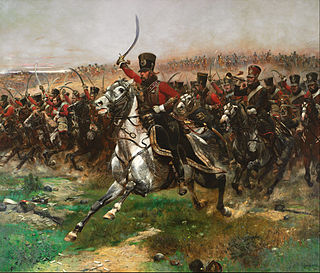
Cavalry are soldiers or warriors who fight mounted on horseback. Cavalry were historically the most mobile of the combat arms, operating as light cavalry in the roles of reconnaissance, screening, and skirmishing in many armies, or as heavy cavalry for decisive shock attacks in other armies. An individual soldier in the cavalry is known by a number of designations depending on era and tactics, such as cavalryman, horseman, trooper, cataphract, knight, hussar, uhlan, mamluk, cuirassier, lancer, dragoon, or horse archer. The designation of cavalry was not usually given to any military forces that used other animals for mounts, such as camels or elephants. Infantry who moved on horseback, but dismounted to fight on foot, were known in the early 17th to the early 18th century as dragoons, a class of mounted infantry which in most armies later evolved into standard cavalry while retaining their historic designation.
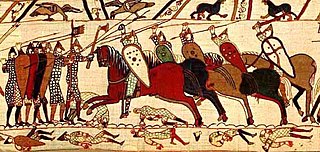
A lance is a pole weapon designed to be used by a mounted warrior or cavalry soldier (lancer). During the periods of classical and medieval warfare, it evolved into being the leading weapon in cavalry charges, and was unsuited for throwing or for repeated thrusting, unlike similar weapons of the javelin and pike family typically used by infantry. Lances were often equipped with a vamplate – a small circular plate to prevent the hand sliding up the shaft upon impact. Though best known as a military and sporting weapon carried by European knights, the use of lances was widespread throughout Asia, the Middle East, and North Africa wherever suitable mounts were available. As a secondary weapon, lancers of the medieval period also bore daggers, swords, axes, hammers, or maces for hand-to-hand combat, since the lance was often a one-use-per-engagement weapon; assuming the lance survived the initial impact intact, it was usually too long, heavy, and slow to be effective against opponents in a melee.
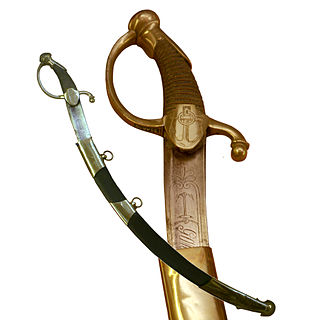
A sabre is a type of backsword with a curved blade associated with the light cavalry of the early modern and Napoleonic periods. Originally associated with Central European cavalry such as the hussars, the sabre became widespread in Western Europe in the Thirty Years' War. Lighter sabres also became popular with infantry of the late 17th century. In the 19th century, models with less curving blades became common and were also used by heavy cavalry.

The Polish cavalry can trace its origins back to the days of medieval cavalry knights. Poland is mostly a country of flatlands and fields and mounted forces operate well in this environment. The knights and heavy cavalry gradually evolved into many different types of specialised mounted military formations, some of which heavily influenced western warfare and military science. This article details the evolution of Polish cavalry tactics, traditions and arms from the times of mounted knights and heavy winged hussars, through the times of light uhlans to mounted infantry equipped with ranged and mêlée weapons.

The Bofors 37 mm anti-tank gun was an anti-tank gun designed by Swedish manufacturer Bofors in the early 1930s originally for Swedish use. It was exported to several countries during the 1930s of which several bought licences to produce it themselves. The gun was used in several conflicts but most of its fame comes from its use in the Spanish Civil War and the Winter War where it was used very successfully against light tanks and armored cars among other targets. Beyond its use as an infantry gun it was also used as the main armament in several armored cars and tanks such as the Dutch M39 Pantserwagen and the Polish 7TP to name a few. As the armor of tanks was increased during World War II the gun very quickly became obsolete as an anti-tank gun but was still used effectively as an infantry support gun for the entirety of the war, and well into the Cold War. This was due to its high fire rate, great mobility and effective high explosive shells.

Uhlans were Polish-Lithuanian light cavalry units armed with lance, sabre, and pistols. The Polish uhlans became the model for many general-purpose cavalry units throughout Europe as use of traditional heavy cavalry declined starting in the early 19th century. The title was later used by lancer regiments in French, Russian, Prussian, Saxon, Austrian, and other armies.
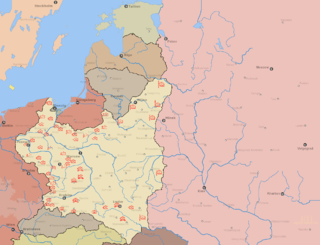
Polish OOB during the invasion of Poland. In the late thirties Polish headquarters prepared "Plan Zachód", a plan of mobilization of Polish Army in case of war with Germany. Earlier, the Poles did not regard the Germans as their main threat, priority was given to threat from the Soviets.

A lancer was a type of cavalryman who fought with a lance. Lances were used in mounted warfare by the Assyrians as early as 700 BC and subsequently by Greek, Persian, Gallic, Chinese, and Roman horsemen. The weapon was widely used throughout Eurasia during the Middle Ages and the Renaissance by heavy cavalry, before being adopted later on by light cavalry. In a modern context, a lancer regiment usually denotes an armoured unit.

Szabla is the Polish word for sabre.
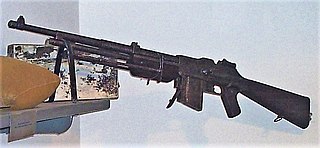
The Browning wz.1928 is a Polish version of the M1918 BAR. It was a light machine gun used by the Poles in World War II.

Ckm wz. 30 is a Polish-made clone of the American Browning M1917 heavy machine gun. Produced with various modifications such as greater caliber, longer barrel and adjustable sighting device, it was an improved although unlicensed copy of its predecessor, and was the standard machine gun of the Polish Army since 1931.

The Karabinek wz.29 was a Polish bolt-action short rifle based on the German Kar98AZ. Identifying attributes include a 98/05 style mast bayonet lug ending directly beneath the front sight and winged protective ears to either side of the front sight blade. Cavalry models featured a turned-down bolt handle, and early versions had a stacking hook near the end of the stock on the right side.

The hełm wz. 31 was the basic combat helmet of the Polish Army before the outbreak of World War II and during the Invasion of Poland. The helmet became the basic type of combat headgear for Polish military formations in 1930s and during the early stages of World War II. It was also exported to Persia, Albania and Republican Spain. By September 1939 approximately 320,000 copies were delivered to the Polish Army.

The 1908 Pattern Cavalry Trooper's Sword was the last service sword issued to the cavalry of the British Army. It has been called the most effective cavalry sword ever designed, although its introduction occurred as swords finally became obsolete as military weapons. In use, it, like other thrust-based cavalry swords, is best described as a one-handed lance, due to its complete lack of utility for anything but the charge. In fact, the closely related US Model 1913 Cavalry Saber was issued with only a saddle scabbard, as it was not considered to be of much use to a dismounted cavalryman. Colonial troops, who could expect to engage in melee combat with opposing cavalry frequently carried cut and thrust swords either instead of, or in addition to, the P1908/1912.

The basket-hilted sword is a sword type of the early modern era characterised by a basket-shaped guard that protects the hand. The basket hilt is a development of the quillons added to swords' crossguards since the Late Middle Ages. In modern times, this variety of sword is also sometimes referred to as the broadsword.
Military Institute of Armament Technology is a Polish scientific institution responsible for the research and development of new technologies for use by the military. It is based in Zielonka at the outskirts of Warsaw. Subordinate to the Ministry of National Defence, the institute is considered one of "central institutions", that is one of state-owned institutions essential to the functioning of the state.

The Model 91/98/23 carbine often shortened to kbk wz. 91/98/23, and its variants wz. 91/98/25 and wz. 91/98/26, were a Polish modification of the Mosin–Nagant M1891 rifle to carbine form. The Mosin rifle was shortened and converted to use the 7.92×57mm Mauser cartridge.

11th Legions Infantry Regiment of Marshal Edward Smigly-Rydz was a cavalry unit of the Polish Army, which existed in 1918 – 1939. It fought in the Polish-Soviet War and the Invasion of Poland. In the Second Polish Republic, the regiment was garrisoned in Ciechanow, and in 1939, belonged to Mazowiecka Cavalry Brigade.

The Presidential Horse Guard Mounted Ceremonial Squadron, shortened as the Representative Squadron of the Polish Army is a cavalry unit that is part of the 1st Guards Battalion, Representative Honor Guard Regiment of the Polish Armed Forces. It serves as the travelling mounted escort of the President of Poland, who serves as the Supreme Commander of the Polish Armed Forces. This cavalry unit, raised in 2000, is the successor of the heritage and traditions of the cavalry units of the Polish Land Forces dating from many centuries. Apart from the escort of dignitaries, it also participates in ceremonial military parades, official anniversary celebrations and historical reenactments.

These swords were used by the Turkic nomads of the Eurasian steppes primarily between the 9th and 14th centuries. One of the earliest recorded sabres of this type was recovered from an Avar grave in Romania dating to the mid 7th century. Although minor variations occur in size and hilt, they are common enough in design across 5 centuries that individual blades are difficult to date when discovered without other context.



















